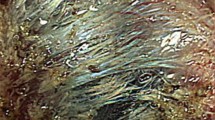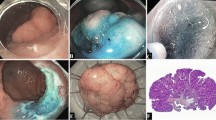Abstract
Purpose
Since colorectal endoscopic submucosal dissection (ESD) requires higher-level skills than endoscopic mucosal resection (EMR), it is recommended to acquire sufficient experience in gastric ESD prior to attempting colorectal ESD. We evaluated the ability of experienced endoscopists with limited experience in gastric ESD to perform colorectal ESD.
Methods
We retrospectively reviewed 120 colorectal ESDs performed by two endoscopists who had expertise in colonoscopy and colorectal EMR but experience of fewer than five gastric ESDs. Main outcomes were the en bloc resection rate with tumor-free margins (R0 resection rate) and adverse events rate. Using only clinical characteristics prior to ESD, we also identified factors affecting outcomes.
Results
A total of 113 patients (94.2 %) received en bloc resection, and the R0 resection rate was 80.0 % (96/120). Perforation and postoperative hemorrhage occurred in eight (6.7 %) and two (1.7 %) patients, respectively. Dividing the 120 cases into three learning phases, R0 resection and perforation rates improved from 77.5 % (31/40) and 12.5 % (5/40) in phase 1 to 85.0 % (34/40) and 2.5 % (1/40) in phase 3, respectively. Multivariate analysis revealed that lesions at junctions (dentate line, sigmoid-descending junction, splenic flexure, hepatic flexure, ileocecal valve) and lesions with factors reflecting fibrosis in the submucosal layer (based on endoscopic findings before ESD) were significantly correlated with R0 resection failure, with adjusted odds ratios of 10.5 (95 % CI 2.1–67.6) and 10.4 (2.7–48.6), respectively.
Conclusions
Colorectal ESD is feasible for experienced endoscopists with limited experience in gastric ESD. Novices should avoid lesions at junctions or those with factors reflecting fibrosis.


Similar content being viewed by others
References
Repici A, Hassan C, De Paula PD, Pagano N, Arezzo A, Zullo A, Lorenzetti R, Marmo R (2012) Efficacy and safety of endoscopic submucosal dissection for colorectal neoplasia: a systematic review. Endoscopy 44(2):137–150. doi:10.1055/s-0031-1291448
Taku K, Sano Y, Fu KI, Saito Y, Matsuda T, Uraoka T, Yoshino T, Yamaguchi Y, Fujita M, Hattori S, Ishikawa T, Saito D, Fujii T, Kaneko E, Yoshida S (2007) Iatrogenic perforation associated with therapeutic colonoscopy: a multicenter study in Japan. J Gastroenterol Hepatol 22(9):1409–1414. doi:10.1111/j.1440-1746.2007.05022.x
Oka S, Tanaka S, Kanao H, Ishikawa H, Watanabe T, Igarashi M, Saito Y, Ikematsu H, Kobayashi K, Inoue Y, Yahagi N, Tsuda S, Simizu S, Iishi H, Yamano H, Kudo SE, Tsuruta O, Tamura S, Saito Y, Cho E, Fujii T, Sano Y, Nakamura H, Sugihara K, Muto T (2010) Current status in the occurrence of postoperative bleeding, perforation and residual/local recurrence during colonoscopic treatment in Japan. Dig Endosc: Official journal of the Japan Gastroenterological Endoscopy Society 22(4):376–380. doi:10.1111/j.1443-1661.2010.01016.x
Tanaka S, Oka S, Chayama K (2008) Colorectal endoscopic submucosal dissection: present status and future perspective, including its differentiation from endoscopic mucosal resection. J Gastroenterol 43(9):641–651. doi:10.1007/s00535-008-2223-4
Yoshida N, Wakabayashi N, Kanemasa K, Sumida Y, Hasegawa D, Inoue K, Morimoto Y, Kashiwa A, Konishi H, Yagi N, Naito Y, Yanagisawa A, Yoshikawa T (2009) Endoscopic submucosal dissection for colorectal tumors: technical difficulties and rate of perforation. Endoscopy 41(9):758–761. doi:10.1055/s-0029-1215028
Hotta K, Oyama T, Shinohara T, Miyata Y, Takahashi A, Kitamura Y, Tomori A (2010) Learning curve for endoscopic submucosal dissection of large colorectal tumors. Dig Endoscopy: official journal of the Japan Gastroenterological Endoscopy Society 22(4):302–306. doi:10.1111/j.1443-1661.2010.01005.x
Niimi K, Fujishiro M, Goto O, Kodashima S, Koike K (2012) Safety and efficacy of colorectal endoscopic submucosal dissection by the trainee endoscopists. Dig Endosc: official journal of the Japan Gastroenterological Endoscopy Society 24(Suppl 1):154–158. doi:10.1111/j.1443-1661.2012.01251.x
Fujishiro M, Yahagi N, Kakushima N, Kodashima S, Muraki Y, Ono S, Yamamichi N, Tateishi A, Oka M, Ogura K, Kawabe T, Ichinose M, Omata M (2007) Outcomes of endoscopic submucosal dissection for colorectal epithelial neoplasms in 200 consecutive cases. Clin Gastroenterol Hepatol: the official clinical practice journal of the American Gastroenterological Association 5(6):678–683. doi:10.1016/j.cgh.2007.01.006, quiz 645
Tamegai Y, Saito Y, Masaki N, Hinohara C, Oshima T, Kogure E, Liu Y, Uemura N, Saito K (2007) Endoscopic submucosal dissection: a safe technique for colorectal tumors. Endoscopy 39(5):418–422. doi:10.1055/s-2007-966427
Tanaka S, Oka S, Kaneko I, Hirata M, Mouri R, Kanao H, Yoshida S, Chayama K (2007) Endoscopic submucosal dissection for colorectal neoplasia: possibility of standardization. Gastrointestinal endoscopy 66(1):100–107. doi:10.1016/j.gie.2007.02.032
Saito Y, Uraoka T, Matsuda T, Emura F, Ikehara H, Mashimo Y, Kikuchi T, Fu KI, Sano Y, Saito D (2007) Endoscopic treatment of large superficial colorectal tumors: a case series of 200 endoscopic submucosal dissections (with video). Gastrointestinal endoscopy 66(5):966–973. doi:10.1016/j.gie.2007.02.053
Isomoto H, Nishiyama H, Yamaguchi N, Fukuda E, Ishii H, Ikeda K, Ohnita K, Nakao K, Kohno S, Shikuwa S (2009) Clinicopathological factors associated with clinical outcomes of endoscopic submucosal dissection for colorectal epithelial neoplasms. Endoscopy 41(8):679–683. doi:10.1055/s-0029-1214979
Saito Y, Uraoka T, Yamaguchi Y, Hotta K, Sakamoto N, Ikematsu H, Fukuzawa M, Kobayashi N, Nasu J, Michida T, Yoshida S, Ikehara H, Otake Y, Nakajima T, Matsuda T, Saito D (2010) A prospective, multicenter study of 1111 colorectal endoscopic submucosal dissections (with video). Gastrointest Endosc 72(6):1217–1225. doi:10.1016/j.gie.2010.08.004
Deprez PH, Bergman JJ, Meisner S, Ponchon T, Repici A, Dinis-Ribeiro M, Haringsma J (2010) Current practice with endoscopic submucosal dissection in Europe: position statement from a panel of experts. Endoscopy 42(10):853–858. doi:10.1055/s-0030-1255563
Iacopini F, Bella A, Costamagna G, Gotoda T, Saito Y, Elisei W, Grossi C, Rigato P, Scozzarro A (2012) Stepwise training in rectal and colonic endoscopic submucosal dissection with differentiated learning curves. Gastrointest Endosc 76(6):1188–1196. doi:10.1016/j.gie.2012.08.024
Suzuki H, Gotoda T, Sasako M, Saito D (2006) Detection of early gastric cancer: misunderstanding the role of mass screening. Gastric Cancer: official journal of the International Gastric Cancer Association and the Japanese Gastric Cancer Association 9(4):315–319. doi:10.1007/s10120-006-0399-y
Shiga H, Endo K, Kuroha M, Kakuta Y, Takahashi S, Kinouchi Y, Shimosegawa T (2014) Endoscopic submucosal dissection for colorectal neoplasia during the clinical learning curve. Surg Endosc 28(7):2120–2128. doi:10.1007/s00464-014-3443-8
Hori K, Uraoka T, Harada K, Higashi R, Kawahara Y, Okada H, Ramberan H, Yahagi N, Yamamoto K (2014) Predictive factors for technically difficult endoscopic submucosal dissection in the colorectum. Endoscopy 46(10):862–870. doi:10.1055/s-0034-1377205
Hayashi N, Tanaka S, Nishiyama S, Terasaki M, Nakadoi K, Oka S, Yoshihara M, Chayama K (2014) Predictors of incomplete resection and perforation associated with endoscopic submucosal dissection for colorectal tumors. Gastrointest Endosc 79(3):427–435. doi:10.1016/j.gie.2013.09.014
Mizushima T, Kato M, Iwanaga I, Sato F, Kubo K, Ehira N, Uebayashi M, Ono S, Nakagawa M, Mabe K, Shimizu Y, Sakamoto N (2014) Technical difficulty according to location, and risk factors for perforation, in endoscopic submucosal dissection of colorectal tumors. Surgical endoscopy. doi:10.1007/s00464-014-3665-9
Sato K, Ito S, Kitagawa T, Kato M, Tominaga K, Suzuki T, Maetani I (2014) Factors affecting the technical difficulty and clinical outcome of endoscopic submucosal dissection for colorectal tumors. Surgical endoscopy. doi:10.1007/s00464-014-3558-y
Workshop. PitP (2003) The Paris endoscopic classification of superficial neoplastic lesions: esophagus, stomach, and colon. Gastrointest Endosc 58(6 Suppl):S3–43
Tanaka S, Tamegai Y, Tsuda S, Saito Y, Yahagi N, Yamano HO (2010) Multicenter questionnaire survey on the current situation of colorectal endoscopic submucosal dissection in Japan. Dig Endosc: official journal of the Japan Gastroenterological Endoscopy Society 22(Suppl 1):S2–8. doi:10.1111/j.1443-1661.2010.00952.x
Probst A, Golger D, Anthuber M, Markl B, Messmann H (2012) Endoscopic submucosal dissection in large sessile lesions of the rectosigmoid: learning curve in a European center. Endoscopy 44(7):660–667. doi:10.1055/s-0032-1309403
Terasaki M, Tanaka S, Shigita K, Asayama N, Nishiyama S, Hayashi N, Nakadoi K, Oka S, Chayama K (2014) Risk factors for delayed bleeding after endoscopic submucosal dissection for colorectal neoplasms. Int J Colorectal Dis 29(7):877–882. doi:10.1007/s00384-014-1901-3
Conflict of interests
Hisashi Shiga, Masatake Kuroha, Katsuya Endo, Tomoya Kimura, Yoichi Kakuta, Yoshitaka Kinouchi, Shoichi Kayaba, and Tooru Shimosegawa have no conflicts of interest or financial relationships to disclose.
Author information
Authors and Affiliations
Corresponding author
Rights and permissions
About this article
Cite this article
Shiga, H., Kuroha, M., Endo, K. et al. Colorectal endoscopic submucosal dissection (ESD) performed by experienced endoscopists with limited experience in gastric ESD. Int J Colorectal Dis 30, 1645–1652 (2015). https://doi.org/10.1007/s00384-015-2334-3
Accepted:
Published:
Issue Date:
DOI: https://doi.org/10.1007/s00384-015-2334-3




